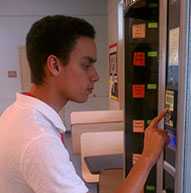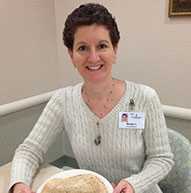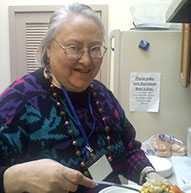Nutrition
This program is no longer funded. Learn more about current DCH programs.

Gilberto Calderin
Reimbursable vending machines provide students with greater access to healthy meals
Miami Dade County, Florida
"I am able to get my lunch more quickly than waiting in line at the cafeteria, and I still have plenty of time to talk to my friends." - Gilberto Calderin
Like many students at Miami Beach Senior High, 18-year-old Gilberto Calderin faces constant time pressures during the school day. With only a half hour to eat lunch each day, he wants to be able to get his food quickly and have time to socialize with his friends. Now, with the recent addition of a vending machine that dispenses yogurt, salads, and sandwiches, Calderin has the opportunity to eat healthy when he has little time.
"Everything is always fresh and healthy," said Calderin, who uses the machine three times a week. "I am able to get my lunch more quickly than waiting in line at the cafeteria, and I still have plenty of time to talk to my friends."
The vending machine, which is restocked every day with fresh food, doesn’t accept money. Instead, students type in their identification numbers and the machine automatically charges their purchases to prepaid accounts. Food sold in the machines qualifies for the U.S. Department of Agriculture’s reimbursable meal program that provides all students, including those who receive free or reduced lunch, with access to healthy meals.
Miami-Dade County Public Schools installed 57 vending machines in schools across the district, benefitting approximately 100,000 students. Meals available in the machines are made from local ingredients and meet national school nutrition standards.
For Calderin, having greater access to healthy meals at school has made him more conscientious about what he eats all the time. "I make an effort now to eat healthy even when I’m not in school," he said.
Increasing access to healthy meals in school is part of a larger effort by Miami-Dade County to reduce obesity prevalence among students. The county has taken the following additional actions to address obesity among young people:
- Training staff members at 960 childcare centers about nutrition, physical activity, and screen time standards
- Encouraging 340 childcare centers and childcare programs to offer healthier option
- Increasing the amount of time that elementary school students take part in physical activity during and outside of school
- Providing 234 bicycle racks throughout the county

Margie Crabtree
Healthy eating made easy for employees of Indiana hospital
Newburgh, Indiana
"Now, because healthy menu options are affordable, I want to eat healthy." - Margie Crabtree
Margie Crabtree admits that she doesn’t always make the healthiest food choices. But, when she buys lunch at her worksite cafeteria, the decision to choose healthy meals is usually easy. Since 2011, Crabtree’s employer, The Women’s Hospital in Newburgh, Indiana, has priced healthy food options at the same or less cost than less healthy options. This approach, which is part of the hospital’s comprehensive employee wellness program, is designed to encourage employees to practice healthy eating.
"Before this program was started, I would be more inclined to eat a cheeseburger at lunch," said the 51-year-old Crabtree. "Now, because healthy menu options are affordable, I want to eat healthy."
For $2.50 a plate, employees can purchase healthy meals such as chicken mandarin salad or parmesan tilapia that follow dietary guidelines for caloric value, fat, carbohydrates, and sodium, as determined by hospital dieticians. The hospital serves an average of 1,000 healthy meals each month to its 500 employees.
Physical activity is another key component of the hospital’s wellness program. Zumba classes are offered regularly and the hospital has an on-site fitness center. Employees also are encouraged to take the stairs and use exercise stations that have been set up in the stairwells.
Because of the overwhelming positive response to the healthy meals program in its first year, the hospital plans to continue to offer subsidized healthy meals for the long term.
Increasing access to healthy food options at worksites is part of an overall effort by Vanderburgh County, Indiana, to make healthy living easier. In addition to The Women’s Hospital, Deaconess Hospital and St. Mary’s Hospital offer healthy menu options at reduced prices for their employees. The county also promotes healthy lunch options in high schools by providing nutritional labeling on food offerings.

Vicki Earl
Healthy aisles contribute to healthy living for West Virginia family
Mid-Ohio Valley, West VA
"Healthy Aisles are a small but important step towards creating a healthy environment." - Vicki Earl
Vicki Earl, a 42-year-old mother of two boys, used to dread the moment when she reached the checkout aisle at her local Walmart because her boys would pressure her to buy candy or some other sugary food on display. Now, Earl rests easy. Candy has been replaced with fruits, vegetables, and nuts.
Walmart’s changes to make candy and sugary food less accessible to children are a welcome to Earl, who has made healthy living a central part of her family’s lifestyle. “Healthy aisles are a small but important step towards creating a healthy environment,” she said. “They reduce the temptation for my kids to want to ask for candy.”
Earl and her husband know that a healthy environment is only one part of healthy living. Having struggled with weight issues, the Earls regularly talk to their children about the importance of diet and exercise. They hope these lessons will help ensure their children live healthy lives.
One-third of adults in Mid-Ohio Valley are obese. Walmart’s healthy checkout aisles are part of a larger community initiative to support healthy living for residents. In recent years, healthy food has become increasingly available through convenience stores and three new farmers’ markets. Street improvements also are being planned to support physical activities like bicycling and walking.

Kae Gaunt
Produce distribution program provides low-income seniors access to fresh fruits and vegetables
Multnomah County, Oregon
"Many vegetables are too expensive for me." - Kae Gaunt
Each Monday morning during the harvest season, 67-year-old Kae Gaunt joins other low-income senior citizens at the Hollywood Senior Center in Multnomah County, Oregon, in picking up free produce provided by a local farmers market. Through this produce distribution program, Gaunt is able to include fresh fruits and vegetables in her diet – items that she would otherwise not be able to afford.
"Many vegetables are too expensive for me," said Gaunt. "And even more so, when you consider the waste from buying vegetables that I can’t finish on my own before they spoil."
At the produce distribution, Gaunt can pick just the amount of vegetables that she plans to eat. For example, instead of having to buy an entire head of lettuce at a store, Gaunt can select just the number of leaves that she plans to eat for the coming week.
Before the senior center began distributing free produce, Gaunt’s meals would typically consist of nutrition shakes. Now she eats soups and other dishes that include vegetables such as broccoli, kale, and bok choy that she obtained at the center. Gaunt’s overall health has improved since she started eating more fruits and vegetables. She’s lost 15 pounds and her gout is now better controlled.
In addition to providing free produce at the Hollywood Senior Center, Multnomah County has implemented a farm-to-senior program to provide low-income elderly residents with access to healthy meals and affordable produce at farmers markets and farm stands. Other initiatives to support healthy eating include the following:
- Supporting nutrition and physical activity standards for approximately 18,000 students in 60 after-school programs
- Supporting school districts to adopt healthy changes in 154 schools
- Establishing the Multnomah County Healthy Retail Initiative to work with local corner store owners to increase the availability and marketing of healthy food and drinks

Anne Haefele
Arizona mother grows fruits and vegetables in the desert
Pima County, Arizona
"The more that I learn about foods, the more interested I am in what I put in my body." - Anne Haefele
Growing fruits and vegetables in the Arizona desert can be a challenge. Rainfall is scarce and temperatures often exceed 100 degrees. But Anna Haefele now has learned the secrets to gardening in these conditions. To combat the desert’s arid conditions, she knows that plants must be watered just below the surface to ensure their roots stay moist. In addition, compost must be mixed into the soil to provide constant nutrients for the plants.
Haefele is among many Tuscon area residents who have learned about urban agriculture at the Las Milpitas de Cottonwood Farm (LMC). The three-acre facility was originally supported by CDC to provide opportunities for residents to grow their own fruits and vegetables.
Professional gardeners assist in day-to-day operations of the farm and lead desert gardening classes that include topics such as selecting native crops that thrive in dry, hot conditions. In its first year, the farm’s 38 plots produced enough fruits and vegetables to feed more than 500 people. The farm is expected to more than double the number of plots, which could feed as many as 1,500 people.
Haefele, a 38-year-old mother of three children, has successfully grown rhubarb, mustard and collard greens, cilantro, carrots, Mexican squash and other vegetables. With increased access to healthy food, Haefele has become more conscious about what she eats. She no longer includes meat in her diet and exercises more often. As a result, she has lost 45 pounds.
"The more that I learn about foods, the more interested I am in what I put in my body," she said. Growing her own fruits and vegetables has not only enabled Haefele to improve her diet, but given her the opportunity to meet different people. As a result, she said LMC has helped create a stronger sense of community for her.
Pima County where Tuscon is located has undertaken a number of efforts to improve access to healthy, affordable food, with the goal of reducing obesity prevalence. In addition to launching LMC, the county has supported 49 new school and community gardens, as well as 500 new home and container gardens. County schools now offer only nutritious and appealing foods in cafeterias and other venues. A year-round farmers’ market also has been established at El Pueblo Park. This market and others throughout the county accept federal food assistance benefits, enabling low-income residents to purchase healthy foods.

Phillip Nguyen
Boston teenager finds growing food leads to healthy eating
Boston, Massachusetts
"My family sees the food that we eat from the seed to the fork." - Phillip Nguyen
Phillip Nguyen used to eat fast food as often as three times per week. That all changed when the 16-year-old started working in a community greenhouse in Boston. Now he cooks meals for his mother and two younger siblings with food that he has grown himself.
“My family sees the food that we eat from the seed to the fork,” said Nguyen. “Being able to grow and prepare food for my family gives us an opportunity to spend time together, which is something I appreciate.”
Nguyen has worked in the greenhouse for the past three years. He helps maintain the raised garden beds in the greenhouse, which produce low-cost, fresh vegetables for local residents.
Working in the greenhouse has provided Nguyen an opportunity to reconnect with his Vietnamese heritage. He serves as a translator for a group of Vietnamese gardeners who use the greenhouse and have taught him traditional gardening techniques.
In addition to growing vegetables, Nguyen has learned about healthy eating. He now pays closer attention to what he eats and how he prepares food and encourages his friends to do the same.
Through the greenhouse, Boston helped make affordable produce available to residents who might not otherwise have access to fresh fruits and vegetables. Other measures the city undertook to tackle obesity included launching a bike-share program and training Wellness Champions to increase quality physical activity in Boston schools.

Terry Weinfurter
Wisconsin resident builds healthier lifestyle through healthy eating and physical activity
Wood County, Wisconsin
"I didn't realize weight loss could have such an impact on blood pressure." - Terry Weinfurter
Terry Weinfurter knew he was overweight. The Wood County, Wisconsin, resident finally decided to address the issue after making a New Year’s resolution to lose weight, enrolling in a diet program, and receiving encouragement from his employer, New Page Corporation, to enroll in its worksite wellness program.
Weinfurter began exercising with a group of co-workers and eating more nutritious food. In less than a year, he shed more than 90 pounds which, in turn, has had positive effects on his overall health. “I didn’t realize weight loss could have such an impact on blood pressure,” said the 51-year-old Weinfurter, who works as a systems analyst. “But I no longer have to take my blood pressure meds.”
New Page Corporation’s wellness program focuses on nutrition, physical activity, and mental health. “Participating in this program has definitely been a lifestyle change for me,” said Weinfurter. “I eat more fruit and vegetables now and pay closer attention to labels.” As part of its nutrition program, New Page installed healthy vending machines to provide employees with healthier food options.
New Page believes a healthier workforce benefits everyone. Healthy employees are happier, more energetic, and more productive. They take fewer sick days and have lower health care costs. The company anticipates that this will translate to a stronger bottom line.
Wood County has adopted a number of initiatives to decrease the prevalence of obesity among its residents, including launching the: Get Active. Cause. Community. Change. public awareness initiative to build community support for local efforts to improve nutrition and increase residents' physical activity; creating 19 new gardens at childcare centers serving 1,800 children to support increased fruit and vegetable consumption and early learning about healthy meal choices; providing 22 childcare centers with resources—including training, tools, and curriculum—to improve children's nutrition and increase their physical activity; and improving courthouse visitors' and employees' access to nutritious snacks by ensuring that 75 percent of vending options are healthy.
- Page last reviewed: November 22, 2013
- Page last updated: November 22, 2013
- Content source:



 ShareCompartir
ShareCompartir